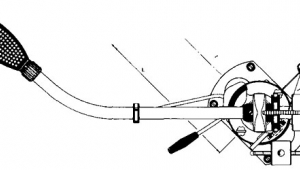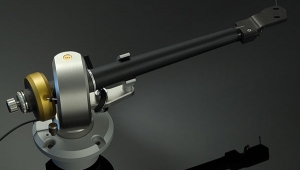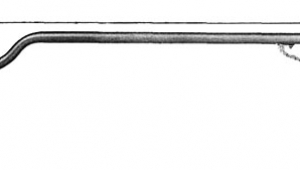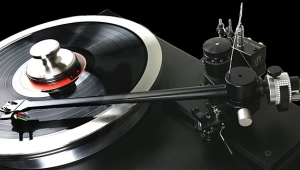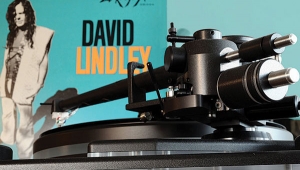| Columns Retired Columns & Blogs |
The Well-Tempered Arm More RH
Robert Harley wrote about the Well-Tempered Black Arm in April 1993 (Vol.16 No.4):
The Black Well-Tempered Arm is very similar to the original WTA, but with a few changes. The Black Arm features a thicker aluminum (instead of stainless steel) arm tube, a new headshell that has two mounting holes for a more secure mechanical connection to the cartridge, and a single large stainless-steel counterweight. The wiring is also updated, and the terminal block is fitted with higher-quality RCA jacks.
The Black Arm can be bought separately for $900. Owners of the original WTA can have theirs upgraded for $300. The upgrade package includes new arm tube, headshell, fresh silicone fluid, new wiring, and higher-quality RCA jacks. The arm tube is filled with the same damping sand as in the original arm. The $300 upgrade price is based on the customer rehanging his own arm: Transparent charges an additional $70 if the entire arm assembly is received and returned to the customer ready to install.
Speaking of rehanging the arm, this is absolutely the last set of WTA mods I'll review: removing the arm, draining the messy silicone fluid, rehanging the arm, and remounting the cartridge (not to mention resetting azimuth, tracking force, and VTA) are not my idea of fun—particularly when there are records to be enjoyed.
I should warn readers that my experience of the Black arm may not exactly match theirs; there are so many variables in changing arms that it is impossible to guarantee that every parameter is identical after switching arms. While I attempted to match tracking force, VTA, how deep the paddle lay in the silicone, azimuth, and anti-skate, it's possible that these were not identical with both tonearms. I did, however, optimize the Black Arm's performance after listening to it under the same conditions as the original arm. Further, my comparison of the Black Arm was with the Lary Pederson–modified WTA, not the stock arm. Readers are advised to read my "Follow-Up" of that modification in Vol.15 No.1.
Although I thought each of the products tried in this survey had an unquestionable benefit, I had mixed feelings about the Black Arm. In some respects it was clearly better than the modified standard arm, but was by no means the clear winner overall. The biggest improvement rendered by the Black Arm was in the quantity and quality of bass. The Black Arm had a much weightier presentation, with what seemed like an octave greater extension. Bass drum had more kick and power, a welcome addition to my system. In addition, the entire bass had more weight. This fuller, deeper bass, improved by both the Black Arm and Black Platter, may put an end to the WTT's reputation for lightweight presentation. With the full updates, the WTT can now hold its own in terms of bass power, depth, and dynamics.
The Black Arm also had greater resolving power, particularly in the treble. There was more detail, life, and air in the top octave. I felt, however, that the Black Arm crossed the fine line between resolution and becoming analytical. There was just a little too much detail for my taste. Moreover, treble detail tended to become etched, somewhat hard, and fatiguing compared to the LP Lab–modified arm.
Adding to this impression of an uptilted treble was a lack of warmth in the mids. Instrumental timbres were "whiter," and missing some body as a result. Violins became more wiry and thin, rather than full-bodied. The Harmonia Mundi LP of Handel's Water Musik (HMU 7010) was a good example of this tendency. I heard more detail and air in this recording with the Black Arm, but instrumental textures were more natural with the LP-modified original. Similarly, cymbals had more air and extension in the top octave, but their brighter, more forward character could make the music fatiguing.
To its credit, the Black Arm had a more solid center image, with a greater ability to make the loudspeakers disappear. Image placement within the soundstage was superior with the Black Arm, as were the illusions of depth and size.
Overall, which arm one prefers will be highly system-dependent. I tended to like the LP Lab's modified arm for its smoother presentation, despite the Black Arm's far superior bass and resolving power.—Robert Harley
Robert Harley wrote about the Marigo Well-Damped Arm Clamp in April 1993 (Vol.16 No.4):
A true measure of a product's musical and commercial success is the number of after-market tweaks it inspires. Instead of being an insult to the designer, I see tweaks and modifications as the ultimate expression of affection for the product. The tweaker recognizes a great component and wants to exploit the product's ultimate potential, without regard for the cost considerations that constrained the designer. It is sometimes possible to turn an excellent product into a superlative one with just a few carefully considered tweaks.
Two products that have generated many after-market modifications are the Well-Tempered Turntable and Well-Tempered Arm. I reported on one of these mods, the tonearm modification by Lary Pederson of LP Lab, just over a year ago, in Vol.15 No.1. I found the musical improvement offered by Lary's arm tweaks significant and well worth the mod's very reasonable $200 price...
Perhaps the most extensive and tweakiest WTT mods come from Marigo Audio Labs. Many of Marigo's products will work equally well on any turntable, but several are designed specifically for the WTT and WTA. (Marigo also makes a series of vibrational damping devices that work with any turntable.)
The most intriguing of these is the patented Well Damped Arm Clamp, a solid brass device that fits around the arm cup holding the silicone damping fluid. The Clamp comprises two pieces of machined brass that form a circle around the arm cup. Four hex-head bolts secure the two halves together. Holes have been drilled inside the Clamp (not visible once installed) and filled with a special damping material. A single-point mechanical ground spike protrudes from the Clamp's bottom surface to meet the turntable base. An electrical grounding lug is also provided. The quality of machining, the precision with which the parts fit together (and to the arm cup), and overall execution are first-rate. The $299 Clamp looks and feels like a fine precision instrument.
Although the Clamp will work on the Well-Tempered Arm when mounted on any turntable, its heavy weight (19 ounces) may present a problem for sprung-chassis turntables. This isn't a factor, of course, with the unsprung WTT. Additionally, care must be taken when mounting the Clamp: too much torque on the hex-head bolts can pull the arm cup off its mounting to the base. The best technique is to hold the Clamp from above with the left hand and gently tighten the bolts with the right hand. Installation takes about five minutes.
The theory behind putting such a massive device in intimate contact with the arm cup is straightforward. I'll quote the owner's manual: "In the Well-Tempered Arm design, a portion of the signal generated from the stylus-groove interface travels through the cartridge body, arm tube, and paddle, into the silicone fluid. At infrasonic frequencies, these longer wavelength vibrations are effectively dissipated through molecular shear forces as heat in the silicone fluid. However, the silicone molecules lose the capability of responding to shear to the shorter wavelength vibrations in the audio frequency range, instead becoming an effective vibrational coupler. These vibrations, propagated through the silicone fluid, reach a mechanical impedance boundary condition at the exterior surface of the silicone cup. The vibrations are then reflected back from the boundary to the cartridge causing a relative movement of the stylus. The signal reappears, attenuated, 110 microseconds after initial generation to interact with the information currently being retrieved from the record groove.
"The patented design of the Well Damped Arm Clamp utilizes the coupling capacity of the silicone fluid to provide a termination route for these vibrations. The structure, mass, and damping have been optimized to fully absorb all vibrational energy across the audio band. High inertial mass-loading of the cup completely eliminates mechanical hysteresis effects at low frequencies. A stainless-steel point on the bottom of the Well Damped Arm Clamp provides a single-point mechanical ground for a dissipative path to earth."
But enough of molecular sheer forces and hysteresis effects—what does the Clamp do for the WTA's sonic performance?
In a word, the Clamp's effect was dramatic. After installing the Clamp a few months ago, I heard an improvement in the sound, but only when I removed the Clamp for some comparison listening did I realize just how good this product was. I fully expected to listen for a few weeks without the Clamp to help form my opinion of the product. But on the first record played in months without the Clamp, I immediately knew it wouldn't take long to assess the Clamp's value. The drop in musicality was so great I wanted to reinstate the Clamp immediately.
Specifically, the Clamp provided a much smoother, more liquid, and better focused presentation. The overall tonal balance seemed less uptilted in the treble and with a warmer midrange. Without the Clamp, the treble was slightly etched and forward; putting it back on softened the treble (yet not with a loss of detail), made it less hashy, and gave the presentation a much greater sense of ease. On Mike Garson's The Oxnard Sessions, Volume One (Reference Recordings RR-37), for example, the cymbals were cleaner, less up-front, and sounded more like brass being struck. In my opinion, this improvement in the treble alone is worth the price of admission.
But there's more. The Clamp made midrange textures more liquid; the unClamped arm could sound slightly hard and brittle in the upper mids. The attack of piano notes, for example, had less of an "edge" with the Clamp, a factor that made music more involving and less fatiguing. This was also true of Robert Lucas's voice on the Usin' Man Blues LP (AudioQuest AQ-1001). The Clamp made it more realistic, removing the slightly mechanical quality heard from the unClamped arm. Although the presentation was less edgy, there was an increase in speed and zip. Transient detail was sharper, tighter, better resolved.
The bass was also improved, but not to the same extent as the treble. There was a greater tightness, cohesion, and articulation with the Clamp. Bass lines—Andy West's great playing on the Dixie Dregs' Night of the Living Dregs (Capricorn CPN 0216)—had more punch and drive, adding to the music's rhythmic power. Finally, the Clamp seemed to increase transparency and snap the soundstage into greater focus.
I can't recommend the Well Damped Arm Clamp more highly. The best testimonial to the product's effectiveness is the urgency I felt to reattach it after hearing favorite records played on the WTT/WTA without the Clamp. Marigo Audio Labs can be reached at 1720 N. Marshfield, Chicago, IL 60622. Tel: (312) 235-6450. Fax: (312) 235-5855. Their products can be purchased from dealers, or directly from the factory if no dealer is in your area.—Robert Harley
- Log in or register to post comments


